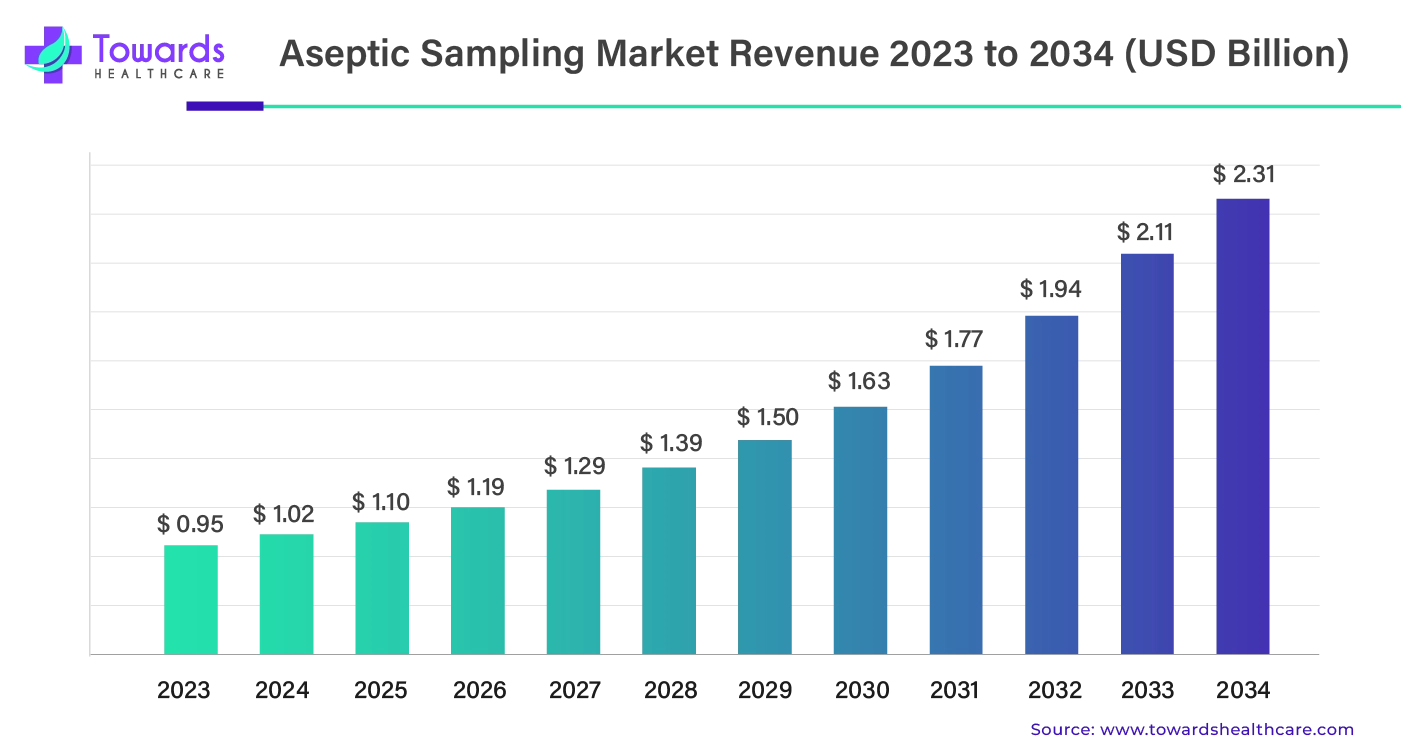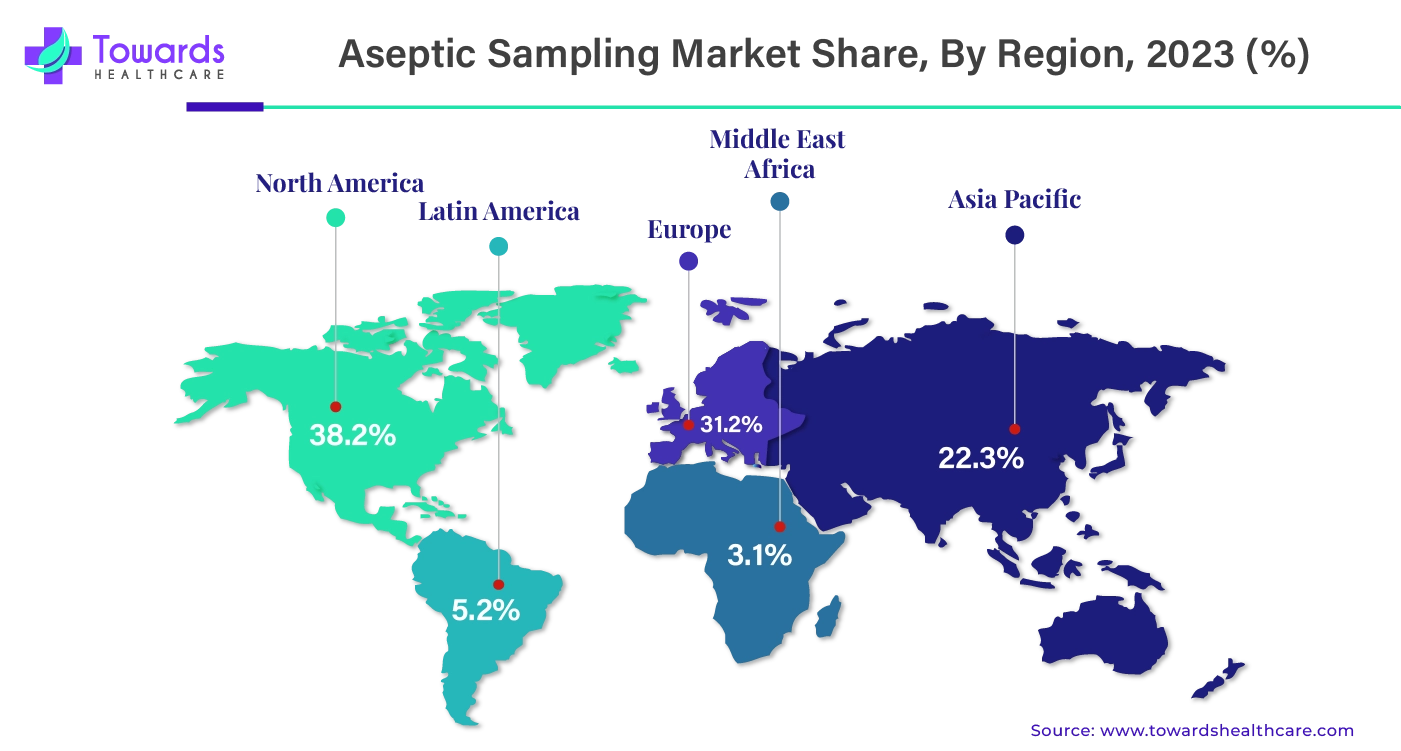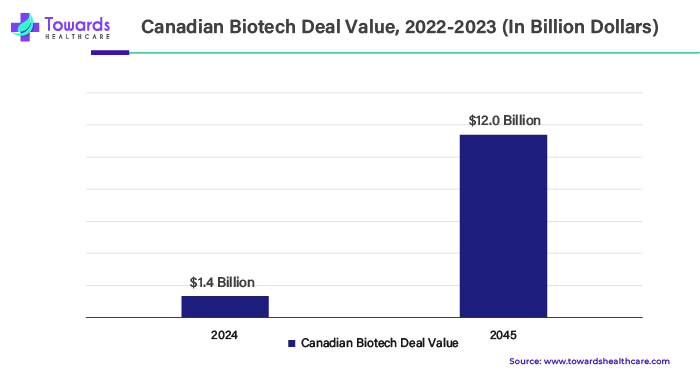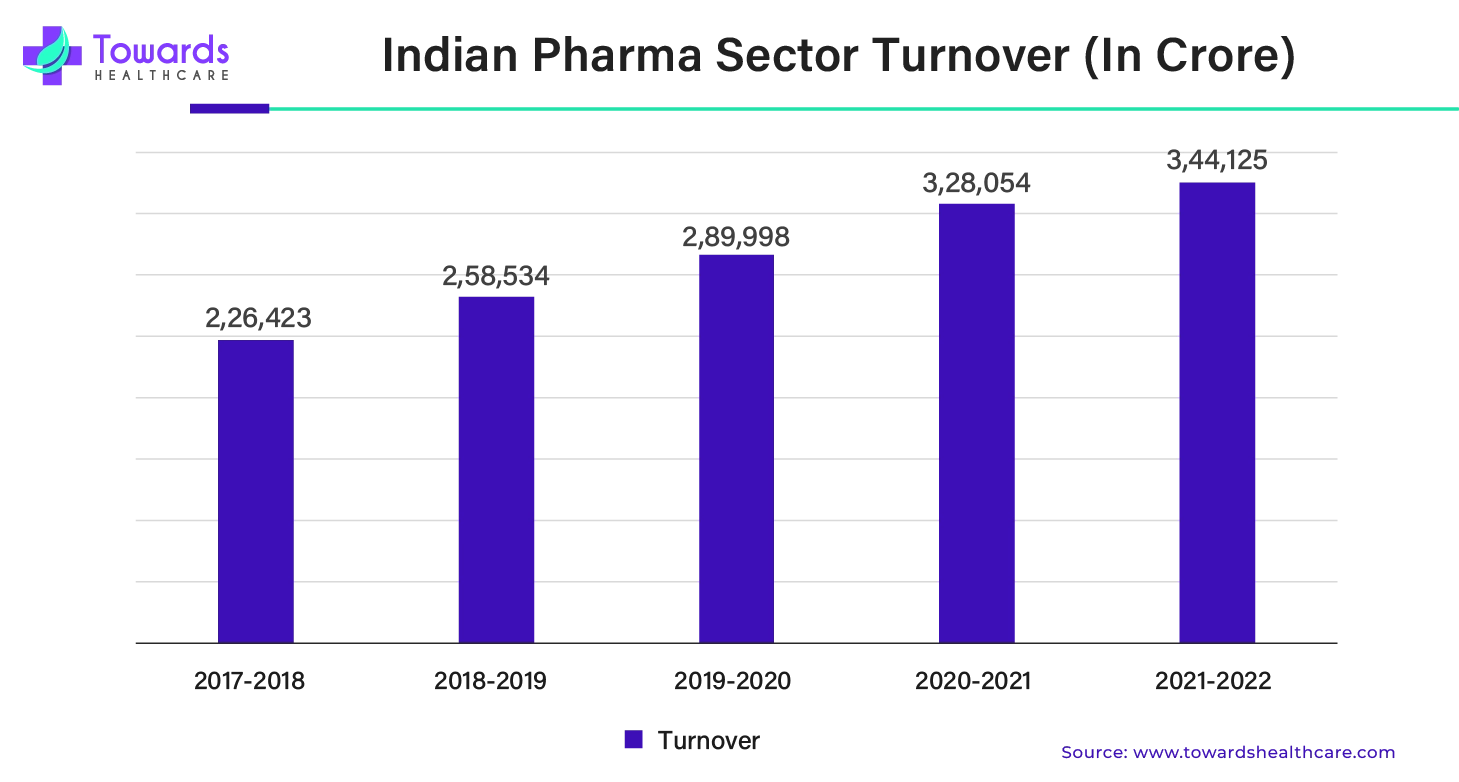November 2025

The global aseptic sampling market was estimated at US$ 0.95 billion in 2023 and is projected to grow to US$ 2.31 billion by 2034, rising at a compound annual growth rate (CAGR) of 7.76% from 2024 to 2034.

| Metric | Details |
| Market Size in 2024 | USD 1.02 Billion |
| Projected Market Size in 2034 | USD 2.31 Billion |
| CAGR (2025 - 2034) | 7.76% |
| Leading Region | North America |
| Market Segmentation | By Type, By Technique, By Application, By End-use, By Region |
| Top Key Players | Danaher Corporation, Syntegon, W. L. Gore & Associates, Merck KGaA, SIG, Sartorius AG, Eppendroff, GEA Group, KEOFITT A/S, Lonza Group, Thermo Fisher Scientific, Qualitru Sampling Systems |
In order to avoid contaminating or changing the sample or its source, aseptic sampling is the technique of aseptically extracting materials utilized in biopharmaceutical operations for analysis. A need for all makers of sterile drugs is microbiological control. The lowering of bioburden is a noteworthy segment of risk mitigation initiatives. Industry groups like PDA and PIC/S, together with regulatory bodies like the FDA, WHO, and EU GMP, provide advice and suggestions to help businesses make the switch from conventional samples to aseptic sampling systems.
Aseptic sampling benefits greatly from AI as it increases efficiency and precision. Artificial intelligence (AI) can examine samples for microbial growth using image recognition algorithms, reducing human error and guaranteeing aseptic conditions are maintained. AI also helps with real-time sample process monitoring, anomaly detection, and quick modification to avoid contamination. By optimizing sample schedules based on previous data, machine learning algorithms can also cut costs and waste. Artificial Intelligence enhances overall accuracy and dependability by freeing up laboratory workers to concentrate on more intricate and crucial facets of aseptic sampling by automating repetitive procedures.
The medications that are produced and sold have been changing throughout the last few years. Nowadays, there is increased competition in the therapeutic market and a notable amount of customized or focused medicines available for common ailments, as well as those that have traditionally been more challenging to treat. The biopharmaceutical industry is now increasingly more prominent. The rise of the biopharmaceutical market is caused by several causes. Increasing patient demand for better healthcare outcomes and a better patient experience is one of them. Other factors include mergers between large pharmaceutical companies and new regulations that encourage greater cooperation between pharmaceutical manufacturers and healthcare providers. Venture capital firms have also increased their investment in early-stage biotech companies.
Every step of the aseptic production process takes place in a clean way that complies with regulatory standards to guarantee the sterility and caliber of pharmaceutical goods. The US Food and Drug Administration (FDA) released the Aseptic Processing Guidelines in 1987. Since then, the FDA has updated the guidelines multiple times to provide more clarity on environmental monitoring techniques, cleanroom and process designs, quality control measures, employee qualification, and production record reviews.
The aseptic sampling market is growing as the pharmaceutical and biotechnology companies are growing in developing countries. Not only are the major players establishing themselves in those countries, but new companies are also establishing and contributing to the market’s growth. With a wide range of partners in the public and private sectors, UNIDO has advanced local pharmaceutical production (LPP) in developing nations by offering technical assistance and advising services. As part of a worldwide effort, UNIDO helped "mainstream" LPP as an issue for global development and enhanced the operating environment and technical capabilities of regional producers. UNIDO now has a robust and active network of partners and is recognized as a leading organization on the LPP agenda as a result of this involvement.
By type, the manual aseptic sampling segment accounted for the largest aseptic sampling market share in 2023. Although it may be used for any type of sampling event, manual sampling works best when it comes to base flow sampling in dry weather conditions or as a backup for automation sampling. The main benefit of manual sampling is its ease of use—filling a container with water is not a particularly tough task. One further significant benefit is the cheap cost of equipment. The project cost for manual sampling, according to the cost analysis, is $4,250, or $531.25 per month. Because aseptic manual sampling has a long history in the pharmaceutical and biopharmaceutical sectors, there is expected to be a significant demand for it. The advent of single-use aseptic sampling techniques has helped businesses steer clear of expensive issues like cross-contamination.
By type, the automated aseptic sampling segment is anticipated to grow at the fastest CAGR in the aseptic sampling market during the forecast period. Computerized solutions that guarantee resilient quality and enable production continuity to satisfy expanding market needs are commonly used to monitor automated aseptic processing. For automated aseptic processing, robotic operations have also grown to be essential as they give thorough records of every operation and enable intelligent data management. These robotic systems have a number of sensors installed that enable them to quickly identify any drift tendencies or production flaws. Therefore, in order to minimize any possible manufacturing losses and guarantee the constant quality of the finished medicinal products, corrective and preventative actions may be swiftly carried out.
For instance,
By technique, the in-line sampling technique segment dominated the aseptic sampling market in 2023. Real-time analysis of the material is done throughout the production process by in-line sampling and analysis. Inline devices carry out continuous measurements without obstructing the material's flow since they are incorporated right into the process stream. Instant feedback and the capacity to swiftly modify the procedure in the event that deviations are noticed are two benefits of this. Inline analysis compensates for speed and convenience by introducing a larger risk of contamination. There are limits to the quantity of data that can be extracted from an inline detector, even with the appropriate tools.
By technique, the on-line sampling technique segment is expected to grow at the fastest rate in the aseptic sampling market during the forecast period. Online sampling and analysis happen concurrently with the process, much like in-line sampling. However, samples are often extracted from the process stream and sent to a nearby analyzer. Online analyses can be run on a continuous basis or on a predetermined schedule. Online measurement, in contrast to offline and at-line procedures, allows for measurement as close to the source as feasible, facilitating quicker analysis and better quality control.
By application, the downstream processing segment held the dominant share of the aseptic sampling market and is estimated to grow at the fastest CAGR during the forecast period. The goal of downstream processing is to extract the desired product from the bioreactor effluent and bring it up to code. Microbial fermentation and downstream processing (DSP) can both benefit from automated aseptic sampling. Automated aseptic sampling has a lot to offer process development. By using this PAT technology, a sample is extracted from its source without the need for physical labor and is sent straight to an analysis or storage location while preserving a closed, sterile sampling environment. Modality-neutral and modular in design, automated aseptic sampling provides adaptable and scalable solutions for its application. It is also possible to integrate this technique with other PAT technologies, such as Raman spectroscopy, to enhance the validation and calibration of data-driven models.
By end-use, the pharmaceutical & biotechnology companies segment held the largest share of the aseptic sampling market in 2023. As the biopharmaceutical industry has evolved significantly in recent years, so have the validation requirements become more stringent, and the understanding of Quality by Design (QbD) and Process Analytical Technology (PAT) has improved, all making aseptic sampling more necessary. When it comes to collecting samples, closed sampling methods have grown popular and have replaced outdated methods such as using glass vials and Steam In-Place Sterilization (SIP) stainless steel valve sampling. In addition to guaranteeing medication safety and contamination control, regulatory bodies require that drug sampling procedures adhere to pertinent laws.
By end-use, the CMOs & CROs segment is estimated to register the fastest growth in the aseptic sampling market during the predicted period. The development and manufacturing of novel medications may be subject to a long variety of regulations. To guarantee a medication is safe for patients once it is on the market, a number of moving components must come together during the discovery, development, research, review, and production stages. As a result, assistance is frequently sought for the various stages of the creation of pharmaceutical medications. These businesses, also known as CDMOs, CROs, and CMOs, support the pharmaceutical and biotechnology sectors.

By region, North America dominated the aseptic sampling market share by 38.2% in 2023. Countries like the U.S. and Canada contribute to the market’s growth in North America. The countries not only have major pharmaceutical and biotechnology market players but also make continuous efforts to promote the pharma-biotech sector through government growth.
| Top Pharma Companies in the U.S. | Top Biotech Companies in the U.S. |
| Abbvie | Johnson & Johnson Services, Inc. |
| Astrazeneca | Amgen Inc. |
| Bristrol Myers Squibb | Pfizer, Inc. |
| GSK | Abbott Laboratories |
| Johnson & Johnson | Biogen |
| Merck & Co | Bristoll-Myers Squibb |
| Novartis | Gilead Sciences, Inc. |
| Pfizer | NVIDIA Healthcare |
| Roche Holding | Walgreens |
| Sanofi |
By 2022, biotechnology and biomanufacturing will be utilized in the U.S. to enhance the quality of life for citizens, according to the Department of Energy (DOE). The DOE Office of Science has announced new funding grants totaling about $178 million to support biotechnology and biomanufacturing research projects. To help biotechnology and biomanufacturing reach a position where biorefineries may be commercialized, the DOE's EERE increased its efforts and allocated a total of $120 million.
Since 2019, there has been a notable increase in the Canadian biotech industry due to both foreign and local investment in the life sciences sector. This growth is indicative of investor confidence in the biotech industry's value. $25.9 billion in investments have been made in over 175 Canadian businesses. Recently, Bellus, Inversago Pharma, and Chinook Therapeutics have attracted financing from Canadian life science startups. Although there have been fewer acquisitions globally, 65 investment agreements totaling $12 billion were recorded in the Canadian biotech sector in 2023.

By region, Asia Pacific is expected to grow at the fastest rate during the forecast period. China, India, Japan, and South Korea are the major contributors to the aseptic sampling market growth. The countries are focusing on the growth of their biotechnology and pharmaceutical industries.
Recent government initiatives in China have given priority to homegrown biotech research. The sector's expansion has benefited substantially from a new national strategy. Between 2013 and 2023, the number of biotech PCT patents awarded to Chinese enterprises increased by almost 720 percent, from 266 to 1,920. Businesses that engage heavily in R&D, such as BeiGene, help the Chinese market expand.
For instance,
India's pharmaceutical sector is well-known for producing affordable vaccines and generic medications at a third-place global volume in pharmaceutical manufacture. The Indian pharmaceutical business is a major worldwide player, providing millions of people with low-cost, accessible generic medications. This is evidenced by the fact that India has the greatest number of pharmaceutical facilities outside of the United States approved by the United States Food and Drug Administration (USFDA), as well as a sizable number of plants compliant with the Good Manufacturing Practices (GMP) of the World Health Organization (WHO) and approved by regulatory bodies in other nations, the industry offers lower costs without sacrificing quality.
The pharmaceutical industry in India contributes significantly to the nation's international commerce and has been steadily producing a trade surplus. In 2021–2022, pharmaceutical exports were Rs. 1,74,955 crore (USD 23.5 billion), while total imports came to Rs. 60,060 crore (USD 8.06 billion). This meant that there was a trade surplus of Rs. 1,14,895 crore (USD 15.44 billion).

Europe is estimated to be significantly growing during the forecast period. Europe is a developed aseptic sampling market that places a high priority on adherence to regulations and superior quality standards. Strict guidelines are enforced by the European Medicines Agency (EMA) for pharmaceutical product testing and manufacture. To guarantee product sterility and safety, this calls for the application of trustworthy Aseptic sampling practices. The need for biopharmaceuticals is rising across Europe. Aseptic sampling is necessary for quality control of these items since they are frequently extremely sensitive. European producers are leading the way in the development of cutting-edge Aseptic Sampling Market technology, such as closed-loop and automated systems, which increase productivity and reduce the danger of contamination. Because of its robust biotechnology and pharmaceutical industries, Germany is anticipated to lead the European aseptic sampling market.
| Company Name | Syntegon |
| Headquarters | Waiblingen, Germany, Europe |
| Recent Development | In June 2024, the food, medtech, and pharmaceutical sectors rely on Syntegon for processing and packaging solutions. The business has presented its most recent innovation. A proprietary Settle Plate Changer (SPC) for automatic viability monitoring in the aseptic filling procedure is the latest innovation. Syntegon will assist clients in adhering to the most recent Annex 1 for both new and old equipment with this creative approach. |
| Company Name | SIG |
| Headquarters | Switzerland, Europe |
| Recent Development | In April 2024, the goal of the SIG Prime 55 In-Line Aseptic is to eliminate the requirement for spouted pouches to be pre-sterilized by a third party. It is currently commercially available and was discussed during the 2024 Anuga FoodTec trade show in Cologne, Germany. By applying SIG's decades-long experience in aseptic filling technology with in-line sterilization—a technique that has proven effective in the field of carton packs—to spouted pouches, this innovative filling system advances technical advancement. |
By Type
By Technique
By Application
By End-use
By Region
November 2025
November 2025
November 2025
November 2025